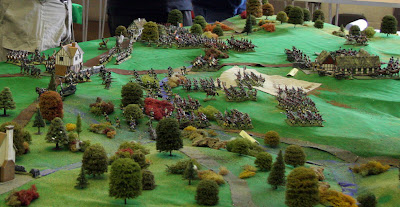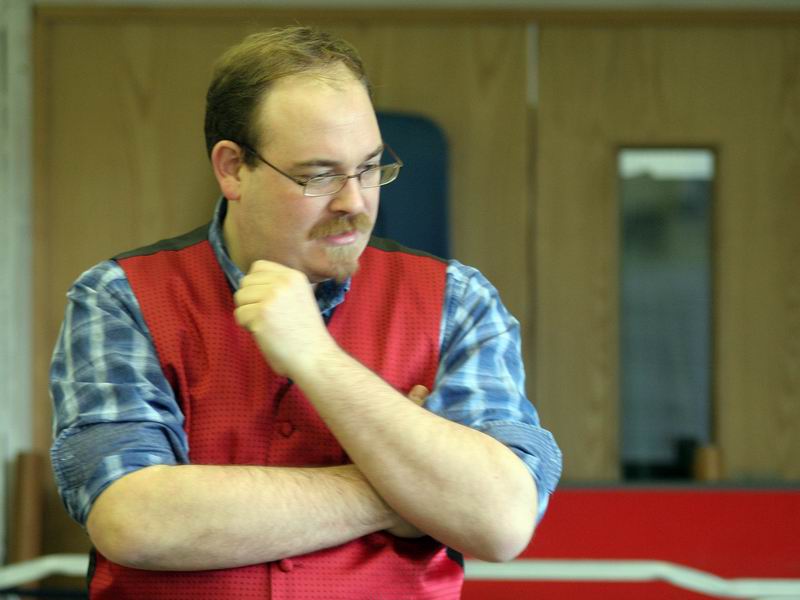 Opening moves
Opening movesAs I said earier I had decided to go with historical deployments. I was also told that the guy playing Napoleon, David Ronaldson, would come at me 'fast and hard'. Indeed, from later battles he was always a man for command of French cavalry, but in this case he was in command of the French army.
I was not too phased by this, fast and hard would arguably be better than predictable and destructive as I was tasked to preserve as much of my command as possible. As the French deployed Peter, as Hohenlohe, hovered around me and muttered 'they are being allowed to deploy further forward than I had thought'. Oh well...
Here is my personal post-battle report with some pics from my perspective (again, courtesy of Major Tom, the photographer-in-chief for the Liphook group and synthetic environment guru for the British Army).

Lannes Attacks
View from the sharp end: Jena from Tauntzein’s perspective
First contactThere is something distinctly satisfying about being the first command to make contact with the enemy, and taking on the role of Tauentzein at Jena made it more-or-less certain that I would be in the firing line first.
As a player I made two decisions, the first about the deployment of the men and the second about the operational plan of the division. In the first case I chose to adopt historical deployments as much as I could, taken from a German staff map from the turn of the century. I did not have to do this and knew it was going to make my job even harder as the brigadiers struggled to get the scattered units back into command in order to face the French. The second decision was to retain the functionality of the division as best I could. Originally Tauentzein held on until the last gasp, but his division disintegrated in the process. My operational orders from Hohenlohe specified that I was to hold on but fall back and form the army reserve on hearing of Frech flank moves (see attached orders) and I was determined to have something to form the reserve with.
The deployment from the map meant that, in effect, brigade Bila was on the left flank, brigade Erichsen on the right, brigade Zweiffel in the centre with Cerrini and his Saxon grenadiers in reserve and holding the village of Lutzeroda with two battalions detatched supporting von Bila. In ‘deep reserve’ was Schonberg’s Saxon brigade, which had historically never received orders to go forward with the rest of Tauentzein’s command and was still in laager at Vierzehnheligen.
The French attack began, and they were allowed to deploy further forward than I had anticipated.
The two infantry divisions of Suchet and Gazan aimed for Closewitz and Lutzeroda respectively whilst the corps cavalry of Lannes was thrown inbetween the two villages. The second surprise came with the rapid fall of Closewitz, garrisoned by Saxon and Prussian grenadiers I had expected it to hold far longer. Instead the division of Suchet made slow but steady progress in the village and against the light infantry of GM von Bila.

The attack on Closewitz
In the centre of the position the cavalry attack against GM von Zweiffel did not produce the spectacular results that the French had seemingly anticipated. Instead of a rapid collapse the brigade gave ground only grudgingly and, when units finally did break (the Saxons, however stayed firm while the Prussians ran) it did not cause the amount of casualties needed to prevent von Zweiffel being able to stitch his brigade back together again.

Closewitz falls
Over on the divisional right, light troops from Gazan’s division plus more from Augereau’s corps made things tough for Erichsen and the Saxon grenadiers holed up in Lutzeroda. Again it was a story of gradual retreat, but the Saxons in Lutzeroda held on far longer than their counterparts in Closewitz and brigade Erichsen was able to withdraw in good order.

The Saxon Grenadiers hold out in 'Fortress' Lutzeroda
WithdrawalTauentzein waved his hat and those units still under command fell back on seeing that the French were now through Closewitz and were pressing back von Bila. Erichsen fell back to the right of Vierzehnheligen, the village itself held by Schomberg’s ‘missing’ brigade. Von Zweiffel and Cerrini’s remaining troops were to head for the gap between Vierzehnheiligen and Krippendorf whilst von Bila was to make for Altengonna. Division Grawert had been instructed to use its cavalry to cover my retreat and they successfully did so allowing the division to retreat more-or-less unmolested.
This allowed Tauentzein to follow his orders and form the reserve battle line along the Hermstedt-Klein Romstedt-Gross Romstedt axis. It did, though, take a long time to shepherd the scattered units back onto the road from Vierzehnheligen to Hermstedt but this was finally achieved, including the rallying of the two routing Prussian battalions by Hohenlohe personally. The brigades of Schomberg and Von Zweiffel were, eventually, lined up between Hermstedt and Klein Romstedt whilst Von Bila’s jager and fusiliers screened the line’s left.
 Forming the reserve (top right)
Forming the reserve (top right)Oberst Erichsen, meanwhile, had been detatched to cover the gap inbetween Grawert’s division and Zeschwitz’ Saxons, who were fighting a private battle of their own against Augereau in the difficult terrain around Isserstedt. Eventually ordered to conform to the rest of the division, Erichsen initially refused to disengage and Tauentzein had to personally ride over and argue with his errant brigadier.
CounterattackWhile Tauentzein was stitching his division back together the divisions of Holtzendorff and Grawert were trying to contain the French along the Vierzehnhelighen-Krippendorf-Altengonna-Lehesten axis. Holtzendorff’s horse had done sterling work in delaying the corps of Soult coming up from Lobstedt and this was to have serious consequences for the French. They were running out of men. Augereau was fully committed against Zeschwitz and seemingly had nothing to spare, whilst the initial attacking corps of Lannes was totally spent. With Soult delayed Napoleon was forced to commit the Guard in order to keep the momentum of the attack going. Supported by its artillery it was no surprise to anyone that the bearskin festooned steamroller broke through Grawert’s force, but two battalions effectively vapourised whilst doing so and the rest got through looking more than a little ropey.
At this stage division Tauentzein received orders to roll forward and plug the gap until von Ruchel arrived, the head of his column could now clearly be seen. Oberst Erichsen was unleashed again to use his meagre cavalry to stave off the horsemen of Murat whilst the brigades of von Bila, von Zweiffel and von Schomberg goose-stepped forward against the Guard.
 Stopping the Guard
Stopping the GuardAnd the battered division of Tauentzein succeeded in stopping them. Von Bila’s light troops formed skirmish order against three battalions of the Old Guard Grenadiers and one promptly disintegrated under their withering fire while the other two looked poorly. An attempt by two battalions of Old Guard Chasseur to attack the 1/Prinz Maximilian was repelled by musketry. The Guard had failed to bring victory. Meanwhile the remains of Holtzendorff and Grawert had used Tauentzein’s division as a shield to withdraw behind and were well on their way back to Hermstedt. It was at this point tat the game came to an end.
ConclusionI could not fail to be happy with the performance of the division. Reading about Tauentzein himself he came across as stubborn, unimaginative and not a man given to questioning orders, and this is how I tried to play him. I had initially made life harder for myself, and the limited command radius of Prussian generals made flexibility something of a misnomer: it took me a total of five turns to bring the division together for the march to Hermstedt, most of that time was spent trying to get units back in command again. This was frustrating, but very accurate.
I could not help thinking that the French would have done better with a slower but more destructive initial attack rather than the rush-job that seemed to take place. Many units that came back for another round should have been utterly destroyed but, instead, by bouncing me out of the position quickly, more troops survived and came back to haunt them.
I was also proud of, in effect, stopping the Guard. They had been badly worn down by Grawert and, having got through them I had made sure that they faced the intact brigade of Schomberg and von Bila’s light troops. I remain fairly convinced that another turn would have said farewell to yet another battalion facing von Bila, and another failure to press home by the battalions facing Schomberg, resulting in more casualties. Only the ‘Eager’ fate card was going to stop them breaking too.
 The boys who stopped the Guard: Fusilier battalion 'Rosen'
The boys who stopped the Guard: Fusilier battalion 'Rosen'My right flank was, it is true, becoming dangerously exposed to Murat’s cavalry and the divisions of Soult were yet to come, but it was close to darkness, I had plenty of withdrawal space, and Ruchel was very close. Understandably the umpires awarded the Prussians a minor victory, I was happy that my division had done its bit...















































